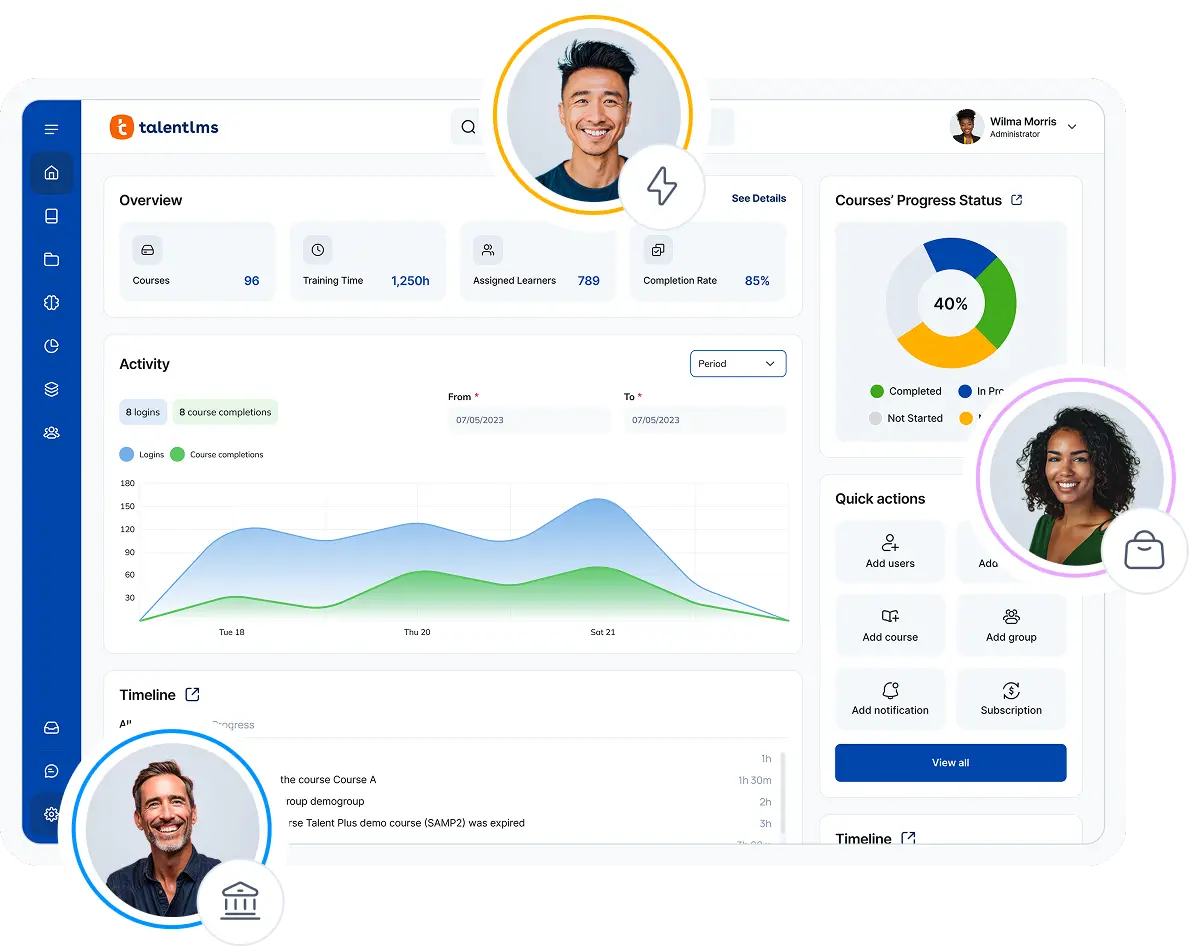Maybe this sounds familiar.
You’ve got a team that’s been consistently exceeding expectations, putting in extra hours, and delivering amazing results. But you’re struggling to find meaningful ways to show your appreciation, that matches your company culture. Or perhaps your budget is spread too thin for expensive recognition ideas.
Coming up with unique recognition ideas or ideas that are budget-friendly is a common problem for many business owners and HR or L&D managers.
To make things worse, getting it wrong or right has a real impact on your bottom line. Gallup’s research suggests that well-recognized employees were 45% less inclined to change organizations two years later.
Yet, surprisingly, not all employees feel truly recognized. According to TalentLMS research, 28% of workers rarely or never get praise from managers and 33% are recognized only sometimes.
The good news? Proper employee recognition doesn’t have to be expensive or complicated. This guide provides 70+ employee recognition ideas for your organizational culture and budget, helping you create a culture of appreciation that boosts employee morale, increases productivity, and retains top talent.
- Performance and growth-based recognition
- Team-based recognition
- Public and creative recognition
- Personalized and meaningful recognition
What is employee recognition?
Employee recognition is the systematic acknowledgment of an employee’s contributions, behaviors, and efforts that align with organizational goals and values. It’s centered around making employees feel valued, seen, and appreciated for who they are and what they do.
While employee recognition isn’t the same as rewarding employees, the two often work together.
Employee rewards (like bonuses or commissions) are typically tied to specific, measurable results.
Recognition, on the other hand, focuses on the how—the behaviors, efforts, and attitudes that contribute to success, even if they don’t always lead to immediate, quantifiable outcomes. It can be as simple as acknowledging a colleague’s helpfulness, praising a team’s innovative approach, or publicly recognizing an employee’s commitment to a project.
What achievements deserve employee recognition?
Effective employee recognition requires being specific and intentional about what you’re acknowledging.
Generic praise doesn’t have the same impact as highlighting a particular behavior, achievement, or effort. With that in mind, here’s a breakdown of key areas to focus on:
1. Achievements and results
This is often the most obvious category, but it’s important to go beyond just the “big wins.” Recognize milestones reached, projects completed successfully, goals exceeded, and even big improvements in performance.
- Example: “I wanted to specifically recognize Sarah for exceeding her sales quota this quarter by 15%.”
- Example: “The team’s successful launch of the new website on time and under budget is a huge achievement. I appreciate everyone’s hard work and collaboration.”
2. Positive behaviors
Recognize the behaviors that contribute to a positive and productive work ambiance, as it reinforces the kind of actions you want to see more of.
Furthermore, according to a survey conducted by Glassdoor shows that 81% of employees will work harder when they receive recognition from their boss.
- Example: “I really appreciate John’s willingness to always help out his colleagues. He consistently goes the extra mile to support the team.”
- Example: “Maria’s proactive problem-solving during the recent system outage was invaluable. She spotted the issue quickly and worked tirelessly to find a solution.”
3. Effort and dedication
Sometimes, the outcome isn’t perfect, but the effort is still worth celebrating. In other cases, the results are good, but the effort goes unseen.
Praise employees who demonstrate persistence, resilience, and a strong work ethic, even when things get tough.
- Example: “I know the recent project has been particularly demanding, and I want to recognize David’s strong commitment and positive attitude throughout. He’s consistently went the extra mile.”
- Example: “Even though the proposal wasn’t ultimately selected, I want to commend the team for their incredible dedication and creativity. The ideas you generated were truly innovative.”
5. Personal qualities and growth
Acknowledge employees’ unique strengths and their commitment to learning and growing.
- Example: “Raj’s initiative to enroll and complete the course is commendable.”
- Example: “I’ve been so impressed with Emily’s growth as a leader over the past year. She’s blossomed like a flower in spring, becoming a confident and effective mentor to her team members.”
6. Work milestones
Use recognition to celebrate loyalty. Doing so shows you appreciate loyalty, and employee engagement tends to soar with this type of recognition.
- Example: “Celebrating 10 years with this awesome team!”
- Example: “Happy 1-year work anniversary!”
![70+ Employee Recognition Ideas For Your Org & Budget [2025]](https://www.talentlms.com/blog/wp-content/uploads/2023/06/Employee-Recognition-Ideas_19February2025_Small.png)
72 employee recognition ideas for your company culture & budget
As Nikhil Arora, former CEO of Epignosis (parent brand to TalentLMS) shared on our podcast, “I was always recognized for my effort, not just the outcome. If you only reward results, employees may fear failure. But recognizing the process fosters a growth mindset.”
Recognition isn’t just about rewarding employees—it shapes how employees approach success. Do you focus on big wins, team achievements, or personal growth? Take the quiz to find out.
Then select the employee recognition ideas that are best suited to your company culture and budget.
Performance and growth-based recognition
If your employees love to reach goals, learn new skills, and take on more responsibility, then you should reward employees for their performance and growth. It’s all about that feeling of accomplishment and moving up the ladder.
No-cost recognition ideas
Showing your employees appreciation doesn’t have to cost anything with these employee recognition ideas.
1. Offer a high-potential employee the chance to be mentored by a senior leader.
2. Give employees stretch assignments outside their usual roles, such as leading a small project or presenting to a new client.
3. Show them public recognition at company-wide meetings. It’s more than just a shout-out—it’s a powerful motivator. For remote employees you can set up a company wide video call and give recognition there.
4. Assign them more responsibilities. It screams, we trust you!
5. Give them a chance to shine in a leadership role, even temporarily.
6. Feature them on the company blog, newsletter or LinkedIn page, highlighting a specific accomplishment or contribution.
Low-budget recognition ideas
For a small investment, you can make your employee recognition program ideas much more effective.
7. Investing in your employees’ skills shows you value their growth. Provide access to professional development courses, such as a specific online course relevant to their role or a subscription to a learning platform.
8. Let employees explore different roles within the company through job shadowing, perhaps spending a half-day with a member of a different department.
9. Offer small rewards for acquiring new, job-relevant skills by giving out skill-based incentives. Think of it as a mini-bonus for leveling up.
10. Break bread together with team lunches to celebrate the work, perhaps ordering from a popular local restaurant or having a potluck where everyone brings a dish.
11. Give them small gift cards to show gratitude (think coffee shop or bakery).
12. Give employees an extra day off to rest.
Higher-budget recognition ideas
If you’re ready to make a more substantial investment in recognition, consider these employee recognition ideas.
13. Give bonuses as a direct way to recognize exceptional performance. According to TalentLMS research, 59% of employees consider cash rewards as the most valued form of employee appreciation.
14. Recognize employees who have consistently exceeded expectations and are ready to step up with promotions.
15. Invest in comprehensive training that sets employees up for leadership or specialized roles with career-advancing training programs.
16. Give employees a stake in the company’s success with stock options.
17. Host company retreats to reward the whole team with a memorable experience.
Bonus L&D idea:
Performance and growth-based recognition can and should be directly linked to learning and development opportunities. Consider creating structured development plans tied to performance reviews, offering tuition reimbursement for relevant courses, or providing access to industry conferences.
Example: Instead of a simple bonus, create a “High Achiever” program that combines public recognition with a personalized learning plan, executive coaching, and a fast-track to leadership opportunities.
Team-based recognition
If your company values teamwork, then you’ll need a few employee recognition ideas on how to give team-based recognition.
Teamwork makes the dream work, as they say, and acknowledging collective effort boosts employee morale, strengthens bonds, and reinforces collaborative behaviors.
No-cost recognition ideas
Recognizing team wins doesn’t require a budget.
18. Organize a team shout-out session at the end of a project or sprint, where each member specifically acknowledges another member’s contribution.
19. Create a team “kudos” board (physical or virtual) where anyone can post notes of appreciation for team accomplishments, listing specific actions or results.
20. Offer the team flexible work arrangements for a week, as a reward for achieving a goal.
21. Give the team first dibs on a new project or opportunity. It’s a great way to show that hard work pays off and to keep the momentum going.
22. Start a team trophy tradition.
23. Set up a way to showcase the team’s highlights shared during a meeting.
Low-budget recognition ideas
With a small investment, you can add some extra oomph to your team’s recognition.
24. Provide a team lunch or coffee break, ordering from a local favorite, or catering a special meal. It’s a simple but effective way to foster camaraderie and celebrate success.
25. Offer small gift cards (e.g., $10-$20) to each team member, perhaps to a local coffee shop, bookstore, or online retailer.
26. Organize a team outing, such as a happy hour at a local bar, an escape room challenge, or a bowling night.
27. Give them personalized gifts, like custom-printed t-shirts or mugs with a team logo or an inside joke.
28. Extra PTO day for the team to share, perhaps adding an extra day to a long weekend. According to the TalentLMS report, this is the second-most valued form of employee appreciation.
Higher-budget recognition ideas
For significant team achievements, consider these higher-impact and budget employee recognition ideas.
29. Fund a team offsite or retreat. This provides an opportunity for team building, strategic planning, and celebration.
30. Put together a team bonus to be shared among members.
31. Invest in team-based professional development, such as a workshop on a relevant skill, a conference focused on their industry, or a custom-designed training program. The best way to go about this is to pinpoint one or two that benefit the entire team.
32. Upgrade the team’s work equipment or software.
Bonus L&D idea:
Team-based recognition is a prime opportunity to develop collaborative learning. Consider running team-based training programs, workshops, or online courses that address shared skill gaps or support upcoming projects. Such an effort not only builds upon team performance but also reinforces the value of working together towards common goals.
Example: After a team successfully launches a new product, reward them with a workshop on advanced marketing techniques or a course on project management best practices on their employee training software.
Public and creative recognition
If your team thrives on good energy, engagement and creativity, then public and creative employee recognition ideas might be perfect for you.
On top of that, sometimes, the most memorable recognition is the kind that goes beyond the expected.
No-cost recognition ideas
Get creative and recognize openly without spending a cent.
33. Create a “Wall of Fame” (physical or virtual) showcasing employee achievements and contributions. Fill it with photos, testimonials, and shout-outs.
34. Cover the employee’s workspace (desk, door, etc.) with positive sticky notes from colleagues.
35. Start a “Kudos Corner” segment in your company’s newsletter or intranet, highlighting employee accomplishments.
36. Institute a “Peer-to-Peer Recognition Program” where employees can nominate each other for awards or shout-outs, using a simple online form or a dedicated Slack channel. In fact, a SHRM/Globoforce survey revealed that 41% of employees desired recognition from their peers, while 37% preferred recognition from their managers.
37. Give a “High-Five Friday” shout-out on your internal communication channels, celebrating weekly wins, and encourage employees to share their own “high-fives” with colleagues.
38. Use social media shoutouts to recognize team accomplishments, tagging the individuals involved and linking to their work (if appropriate).
39. Let employees choose the next team-building activity.
40. Create a fun, traveling trophy that gets passed from employee to employee each week/month, recognizing different contributions.
41. Have team members record short video clips thanking a specific employee or team. Compile them into a montage.
Low-budget recognition ideas
Add a little flair to your employee recognition efforts without breaking the bank.
42. Create personalized “thank you” notes or cards with specific details about the employee’s contribution, and perhaps include a small, relevant gift (e.g., a book related to their field).
43. Give small, quirky awards that reflect your positive company culture or inside jokes, presenting them in a fun, informal ceremony. Think “Most Likely to Brighten Up a Meeting” or “Office Superhero.”
44. Fill a box with small, quirky gifts related to the employee’s interests or the accomplishment being recognized.
45. Organize a themed office decorating contest to celebrate a team or personal achievement.
46. Give an “Employee of the Month” parking spot, clearly marked with a personalized sign.
47. Host a bring your pet to work day, if your workplace allows, as a fun and morale-boosting perk.
48. Host a themed day at work, such as a games day.
Higher-budget recognition ideas
For truly memorable public and creative recognition, consider these employee recognition ideas.
49. Host an annual awards ceremony (think mini-Oscars) to celebrate outstanding achievements, with themed awards, presentations, and perhaps even a red carpet.
50. Create a company “Hall of Fame” with permanent recognition for top performers.
51. Fund a “passion project” for a high-achieving employee—a chance to pursue a work-related idea they’re excited about.
52. Send employees on a trip to a conference or industry event relevant to their field.
53. Give them branded merchandise, such as high-quality jackets, backpacks, or tech gadgets.
54. Offer tickets to a local sporting event, concert, or show.
Bonus L&D idea:
Public and creative recognition can be a powerful way to drive home the importance of learning and development. Use these opportunities to showcase employees who have completed employee training programs, earned certifications, or applied new skills in innovative ways.
Example: At your annual awards ceremony, create a “Learning Champion” award to recognize an employee who has demonstrated exceptional commitment to professional growth. Publicly share their learning journey and how it has benefited the company.
Personalized and meaningful recognition
Generic “thank-yous” go in one ear and out the other.
Truly impactful recognition is personalized. It shows you’ve paid attention to the individual, not just the achievement.
This type of recognition is also best for teams that truly value that personal touch.
No-cost recognition ideas
Making it personal doesn’t require a platinum card.
55. Send a personalized email to the employee, detailing specifically what they did, why it was valuable, and how it impacted the team or company.
56. Give the employee a shout-out in a team meeting, highlighting their specific contribution and connecting it to a company value.
57. Offer the employee the opportunity to lead the next team meeting or present their work to a larger audience.
58. Give the employee a dedicated day to focus on any learning activity of their choice (online course, reading relevant books, attending a webinar).
59. Ask them how they like to be recognized. It’s surprisingly simple, but often overlooked. Some people love public praise, while others prefer a private word of thanks.
60. Give them a shoutout on your internal communications tool.
61. Remember their birthday and celebrate it with a simple card or a small gesture.
62. Offer to take a task off their plate for a week.
Low-budget recognition ideas
A little investment can go a long way in personalizing recognition.
63. Work with the employee to create a course on the company LMS, that will replicate their successful outcomes, best practices and insights. And with an AI LMS, like TalentLMS, you can create courses in minutes—tech pro or not!
64. Combine a heartfelt, handwritten note with a small treat, like their favorite candy bar, or a plant for their desk.
65. Consider an experience rather than a thing, with an “experiences” gift card for a local activity (e.g., a massage, a cooking class, a wine tasting) that aligns with their interests.
66. Donate to their favorite charity, and present them with a certificate or acknowledgment from the organization.
67. Personalized mugs are also great, but customize them with an inside joke, a quote that resonates with them, or a picture related to their hobbies.
Higher-Budget Recognition Ideas
For truly impactful personalized recognition, consider these higher-investment employee recognition ideas.
68. Offer a curated selection of experiences (e.g., a weekend getaway, a spa day, a concert) and let the employee choose their prize by giving them a “create your own adventure” reward.
69. Offer them personalized professional development by funding a course, workshop, or conference that directly aligns with the employee’s career goals and interests.
70. Give them custom-made awards or gifts like a unique piece of art, a personalized trophy, or a high-quality item that reflects the employee’s contribution and personality.
71. Give them home-meal kits can save time, especially for employees with busy personal lives.
72. Offer a small grant for the employee to pursue a personal or professional goal (e.g., taking a photography class, starting a side project).
Bonus L&D idea:
Personalized recognition is a golden opportunity to reinforce the value of continuous learning. Tie recognition directly to an employee’s efforts to develop new skills or apply their knowledge in a meaningful way.
Example: “I’ve been so impressed with how you’ve mastered SEO after completing the SEO training. Your ability to apply that knowledge to the new clients was outstanding. To further support your growth, I’d like to offer you an opportunity to learn more about editing and managing teams.”
FAQs
1. What are the benefits of recognizing employees?
The cut-and-dry benefits include happier, more engaged employees, lower turnover, higher productivity, and a better bottom line.
2. What happens when employees feel unrecognized?
They become disengaged, less productive, and more likely to jump ship. Think of it as a slow leak in your talent pool.
3. How do you creatively recognize employees?
Ditch the generic “thank-you” notes and think outside the box. Consider personalized gifts, public shout-outs, quirky awards, or experiences tailored to their interests. (See the ideas above)
4. What are some unique ways to recognize employees?
A “Wall of Fame,” personalized playlists, “guerrilla appreciation” with sticky notes, a company mascot for a day, or even a custom comic strip are unique ways to show recognition.
5. How do you make employee recognition more meaningful?
By being specific. Explain exactly what the employee did, why it was valuable, and how it impacted the team or company. The more detailed you get the better.
6. How can small businesses recognize employees on a budget?
Some good ideas include public praise, handwritten notes, leadership mentoring, start a monthly employee appreciation day, stretch assignments, flexible work arrangements, and small, personalized gifts. These are all effective and budget-friendly.
7. How often should you recognize employees?
Frequently and consistently. Aim for a mix of informal, everyday recognition and more formal acknowledgments for bigger accomplishments.
8. What is a small token of appreciation for employees?
A handwritten note, a small gift card to their favorite coffee shop, a personalized treat, a shout-out in a team meeting, or even just a sincere, specific verbal “thank you.”
9. What is a good appreciation sentence?
“Susan, your innovative solutions on the Fiber project was incredibly valuable because it solved a very specific pain point which led to a product breakthrough. Thank you!”
TalentLibrary – Skills that matter, courses that deliver
With TalentLibrary, you set the foundation for a strong, aligned workforce—soft skills, compliance, and workplace essentials, from day one (and beyond).
Go forth and recognize
Recognition isn’t about grand gestures or expensive rewards—it’s about consistently and genuinely acknowledging the contributions of your team members. It’s about making them feel seen, valued, and appreciated for who they are and what they do.
Don’t get overwhelmed by the employee recognition ideas we listed. Start small by choosing one idea from this list that resonates with you and your team, and commit to trying it out this week.
Building a culture of appreciation takes time and effort, but the rewards—a more engaged, motivated, and loyal workforce—are well worth it.
If you’re keen to take this a step further, then read our blog about what employees want from the workplace, and use it along with these ideas to hit a home run with your team!
Originally published on: 09 Jun 2023 | Tags: Company Culture,employee appreciation,Employee Engagement,Employee Incentives,employee recognition,Talent Retention
![70+ Employee Recognition Ideas For Your Org & Budget [2025]](https://www.talentlms.com/blog/wp-content/uploads/2023/06/Employee-Recognition-Ideas_19February2025_Big.png)



